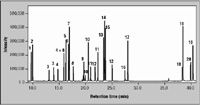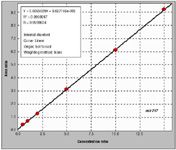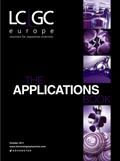Sugar and Sterol Analysis in Human Body Fluids on a Twin Line MS System
Shimadzu Application Note
Screening and follow-up of patients with inborn errors of metabolism are important applications in clinical laboratories. Galactosaemia, for example, is an autosomal recessively inherited disorder in galactose metabolism. Patients are unable to metabolize galactose to glucose. Ingestion of lactose, a disaccharide of galactose and glucose, causes a prolonged rise of blood galactose and the appearance of galactose and galactitol in urine.
Cerebrotendinous xanthomatosis is an autosomal recessively inherited disorder of bile acid synthesis. A deficiency of the mitochondrial enzyme sterol 27-hydroxylase impairs production of chenodeoxycholic acid (CDCA). This results in excessive production of cholestanol and cholesterol and accumulation of these sterols in several tissues and in plasma. Furthermore, these patients excrete bile alcohols in urine.
For identification and quantification of these polyols and sterols such as cholesterol, cholestanol and monosaccharides (e.g., glucose, galactose, galactitol) validated and sensitive GC–MS methods are necessary. Usually, the analyses are performed on two GC–MS systems due to the need for different GC columns. When just one GC–MS is available frequent changing of the columns is necessary. This is time consuming and not acceptable in a clinical laboratory setting with high sample throughput. The optimal solution for this problem is the Shimadzu Twin Line MS System.
The Twin Line MS System enables installation of two capillary columns into the MS simultaneously. This setup allows smooth switching between applications without physically changing the GC column or venting the MS vacuum. Since the outlets of the two columns are directly introduced into the MS interface without using press tight connectors and retention gap columns, existing methods and retention times for a single column can be used. Both analytical assays described above were successfully validated on the dual-column system (both columns installed).
Instrumentation:
GC–MS: GCMS-QP2010 Ultra (Shimadzu)
Autoinjector: Autosampler AOC-20i + s
Column: Monosaccharides and polyols: VF-01 ms WCOT column (20 m × 0.15 mm i.d. df 0.15 µm; Varian)
Sterols: VF-1701 ms WCOT column (30 m × 0.25 mm i.d. df 0.15 µm; Varian)
Analytical Conditions:
Monosaccharides and polyols
GC
Injection temp: 280 °C
Injection mode: Split
Column temp: 120 °C (5 min) – (10 °C/min) – 130 °C – (3 °C/min) – 210 °C – (15 °C/min) – 240 °C – (3 °C/min) – 265 °C – (15 °C/min) – 295 °C (5 min)
Carrier gas: He (constant linear velocity)
Linear velocity: 35 cm/sec
Split ratio: 20
Injection volume: 1 µL
MS
Ion source temp: 200 °C
Interface temp: 250°C
Scan range: m/z 50–400
Event time: 0.36 sec
Sterols
GC
Injection temp: 280 °C
Injection mode: Split
Column temp: 120 °C (1 min) – (75 °C/min) – 270 °C – (3 °C/min) – 300 °C (3 min)
Carrier gas: He (constant linear velocity)
Linear velocity: 35 cm/sec
Split ratio: 80
Injection volume: 1 µL
MS
Ion source temp: 200 °C
Interface temp: 250 °C
Scan range: m/z 50–500
Event time: 0.4 sec
Results
Monosaccharides and polyols
The sample preparation of urine samples for an analysis of monosaccharides and polyols was performed as described by Jansen et al. (1).

Figure 1
Quantification of urinary monosaccharides and polyols was performed by means of internal standard (IS) method. As some analytes had more than one peak (e.g. galactitol) the sum of both peak areas was taken for quantification (Figure 3).

Figure 2
The calibration range was determined by statistical analysis of real sample concentrations. The calibration curve was linear over a range of 1 µmol/mmol creatinine to 750 µmol/mmol creatinine for all monosaccharides and polyols, with a linear correlation coefficient (r) of >0.999 for all compounds. The detection limits (LOD) of the monosaccharides and polyols was ~1 µmol/mmol creatinine (S/N > 10).

Figure 3
Sterols
The preparation of plasma/serum samples for an analysis of sterols was performed as described by Koopman et al. (2).
As for the monosaccharides and polyols the calibration range of the sterols was determined by statistical analysis of real sample concentration. The calibration curve was linear over a range of 1 µmol/L to 8500 µmol/L for cholesterol; 1–85 µmol/L for cholestanol and 1–250 µmol/L for 7- and 8- dehydrocholesterol, with a linear correlation coefficient (r) of >0.990 for all compounds. The detection limit (LOD) of the sterols was ~2 µmol/L (S/N > 5).
Conclusion
Analysis of sugars and sterols demands two different columns to obtain data of the highest quality necessary in the metabolic diagnostics of abnormalities in monosaccharides/polyols and cholesterol metabolism. Since the trimethylsilyl derivatives of many sugars such as glucose and fructose have similar EI mass spectra, the retention time is of particular importance for identification. Therefore running the two applications on one GC–MS while frequently switching the capillary columns is not reasonable. A dual column setup such as the Shimadzu GCMS-QP2010 Ultra (Twin Line system) solves this problem. With just a click of the mouse, the user can switch easily between two analytical lines, between analysis of monosaccharides/polyols or sterols. Although the concentration of sterols (e.g., cholestanol) is very low, identification and quantification works well. The largecapacity differential evacuation system helps to achieve sensitivity comparable to a single column.
References
1. Jansen et al., Clinica Chimica Acta, 157, 277–294 (1986).
2. Koopmann et al., Clinica Chimica Acta, 137, 305–315 (1994).
Shimadzu Europa GmbH
Albert-Hahn-Str. 6–10, D-47269 Duisburg, Germany
tel: +49 203 7687 0
fax: +49 203 76 66 25
E-mail: shimadzu@shimadzu.eu
Website: www.shimadzu.eu

New Method Explored for the Detection of CECs in Crops Irrigated with Contaminated Water
April 30th 2025This new study presents a validated QuEChERS–LC-MS/MS method for detecting eight persistent, mobile, and toxic substances in escarole, tomatoes, and tomato leaves irrigated with contaminated water.
University of Tasmania Researchers Explore Haloacetic Acid Determiniation in Water with capLC–MS
April 29th 2025Haloacetic acid detection has become important when analyzing drinking and swimming pool water. University of Tasmania researchers have begun applying capillary liquid chromatography as a means of detecting these substances.

.png&w=3840&q=75)

.png&w=3840&q=75)



.png&w=3840&q=75)



.png&w=3840&q=75)


















